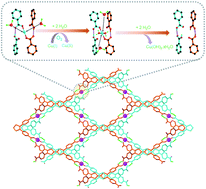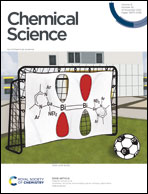Coordination-bond-directed synthesis of hydrogen-bonded organic frameworks from metal–organic frameworks as templates†
Abstract
Controlled synthesis of hydrogen-bonded organic frameworks (HOFs) remains challenging, because the self-assembly of ligands is not only directed by weak hydrogen bonds, but also affected by other competing van der Waals forces. Herein, we demonstrate the coordination-bond-directed synthesis of HOFs using a preformed metal–organic framework (MOF) as the template. A MOF (CuI-TTFTB) based on two-coordinated CuI centers and tetrathiafulvalene-tetrabenzoate (TTFTB) ligands was initially synthesized. CuI-TTFTB was subsequently oxidized to the intermediate (CuII-TTFTB) and hydrated to the HOF product (TTFTB-HOF). Single-crystal-to-single-crystal (SC-SC) transformation was realized throughout the MOF-to-HOF transformation so that the evolution of structures was directly observed by single-crystal X-ray diffraction. The oxidation and hydration of the CuI center are critical to breaking the Cu–carboxylate bonds, while the synergic corbelled S⋯S and π⋯π interactions in the framework ensured stability of materials during post-synthetic modification. This work not only provided a strategy to guide the design and discovery of new HOFs, but also linked the research of MOFs and HOFs.

- This article is part of the themed collection: Most popular 2021 supramolecular chemistry articles, 2021


 Please wait while we load your content...
Please wait while we load your content...